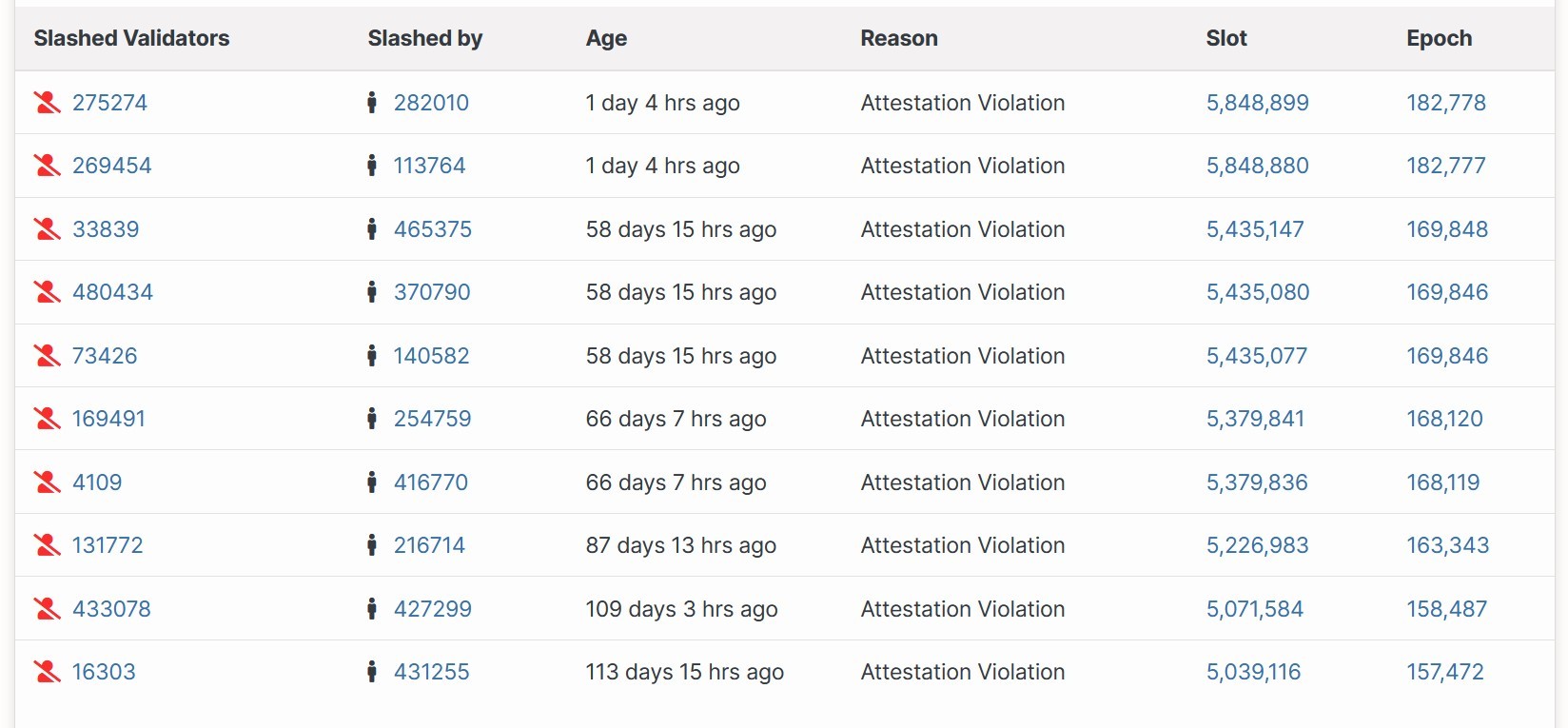Only 0.04% of Ethereum validators have been slashed since 2020, says core dev

The Ethereum ecosystem has seen only 226 validators slashed since the launch of the Beacon Chain on Dec. 1, 2022 — amounting to just 0.04% of 524,060 validators, according to an Ethereum core developer.
Slashing is a process where a validator breaches the proof-of-stake consensus rules, which often results in the removal of that validator from the network and slashing a portion of the staked Ether (ETH) that the validator provided as collateral.
Such slim odds of being slashed were highlighted by Ethereum core developer “Superphiz” in a Feb. 23 Twitter post, which suggests that people shouldn’t be concerned about staking ETH for that particular reason.
226 out of 523,000 validators on the beacon chain have been slashed. This is nothing to lose sleep over. Many slashings have occurred during failed system migration. Here are four emerging best practice tips to avoid this:https://t.co/wleR4YQmDD
— superphiz.eth (@superphiz) February 22, 2023
The developer also explained “four emerging best practices” to reduce those odds even further.
One of these practices was to wipe any existing chain data on old staking machines and to reinstall and reformat the validator where necessary, said Superphiz, noting that many slashings occur due to “failed systems migrations.”
Superphiz then suggested using “doppelganger detection” — which checks whether the validator’s keys are active before starting the validation process.
While this can impact validator uptime, he explained that “perfect uptime” isn’t worth getting slashed in the grand scheme of things:
“It’s wise to throw away $0.06 to save $1700. (A slashing costs about 1 Ether).”
The developer said it is also worth watching buffers and logs on the Beacon Chain to become aware of any potential problems that may arise.

Log of the slashed validators on The Beacon Chain. Source: beaconcha.in.
If something feels wrong, Superphiz suggested “unplugging everything” and to “come back” when the problem has been identified and a proposed solution is set in place.
The developer also noted that over 150 of the 226 slashings have been caused by services rather than “home stakers.”

Staked ETH and number of active validators on The Beacon Chain. Source: beaconcha.in.
Slashing can occur due to an “attestation” or a “proposal” violation, according to the Ethereum Foundation.
An attestation violation is one where a malicious validator attempts to change the history of a block or “double votes” by attesting two candidates for the same block.
A proposal violation occurs when a validator proposes and signs two different blocks for the same slot.
The majority of slashing events have come from attestation violations, according to data from beaconcha.in.
One of the largest slashing events occurred on Feb. 4, 2021, when staking infrastructure provider “Staked” had 75 of its validators slashed for producing competing blocks. Staked said the attestation violation came about due to a “technical issue.”
Since The Beacon Chain merged with the Ethereum proof-of-work chain on Sept. 15, only 35 of the total 226 slashings have taken place, according to beaconcha.in, which suggests that the Merge has not had a profound impact on slashing rates.
With about 16.7 million ETH staked (according to beaconcha.in) out of 120.4 million ETH currently in circulation (according to CoinGecko) — the percentage of ETH staked is about 13.9%.
ETH can be staked on a centralized exchange, be delegated to an third-party validator network or be run on an independent node, which requires 32 ETH.






 Bitcoin
Bitcoin  Ethereum
Ethereum  Tether
Tether  USDC
USDC  TRON
TRON  Dogecoin
Dogecoin  Cardano
Cardano  Bitcoin Cash
Bitcoin Cash  Chainlink
Chainlink  LEO Token
LEO Token  Stellar
Stellar  Monero
Monero  Zcash
Zcash  Litecoin
Litecoin  Hedera
Hedera  Dai
Dai  Cronos
Cronos  OKB
OKB  Tether Gold
Tether Gold  Ethereum Classic
Ethereum Classic  KuCoin
KuCoin  Gate
Gate  Algorand
Algorand  Cosmos Hub
Cosmos Hub  VeChain
VeChain  Dash
Dash  Tezos
Tezos  Stacks
Stacks  TrueUSD
TrueUSD  IOTA
IOTA  Basic Attention
Basic Attention  Theta Network
Theta Network  Decred
Decred  NEO
NEO  Qtum
Qtum  Synthetix
Synthetix  Ravencoin
Ravencoin  0x Protocol
0x Protocol  DigiByte
DigiByte  Zilliqa
Zilliqa  Nano
Nano  Siacoin
Siacoin  Numeraire
Numeraire  Waves
Waves  Ontology
Ontology  Enjin Coin
Enjin Coin  Status
Status  BUSD
BUSD  Hive
Hive  Pax Dollar
Pax Dollar  Lisk
Lisk  Steem
Steem  Huobi
Huobi  NEM
NEM  OMG Network
OMG Network  Augur
Augur  Bitcoin Gold
Bitcoin Gold  Ren
Ren  Bitcoin Diamond
Bitcoin Diamond